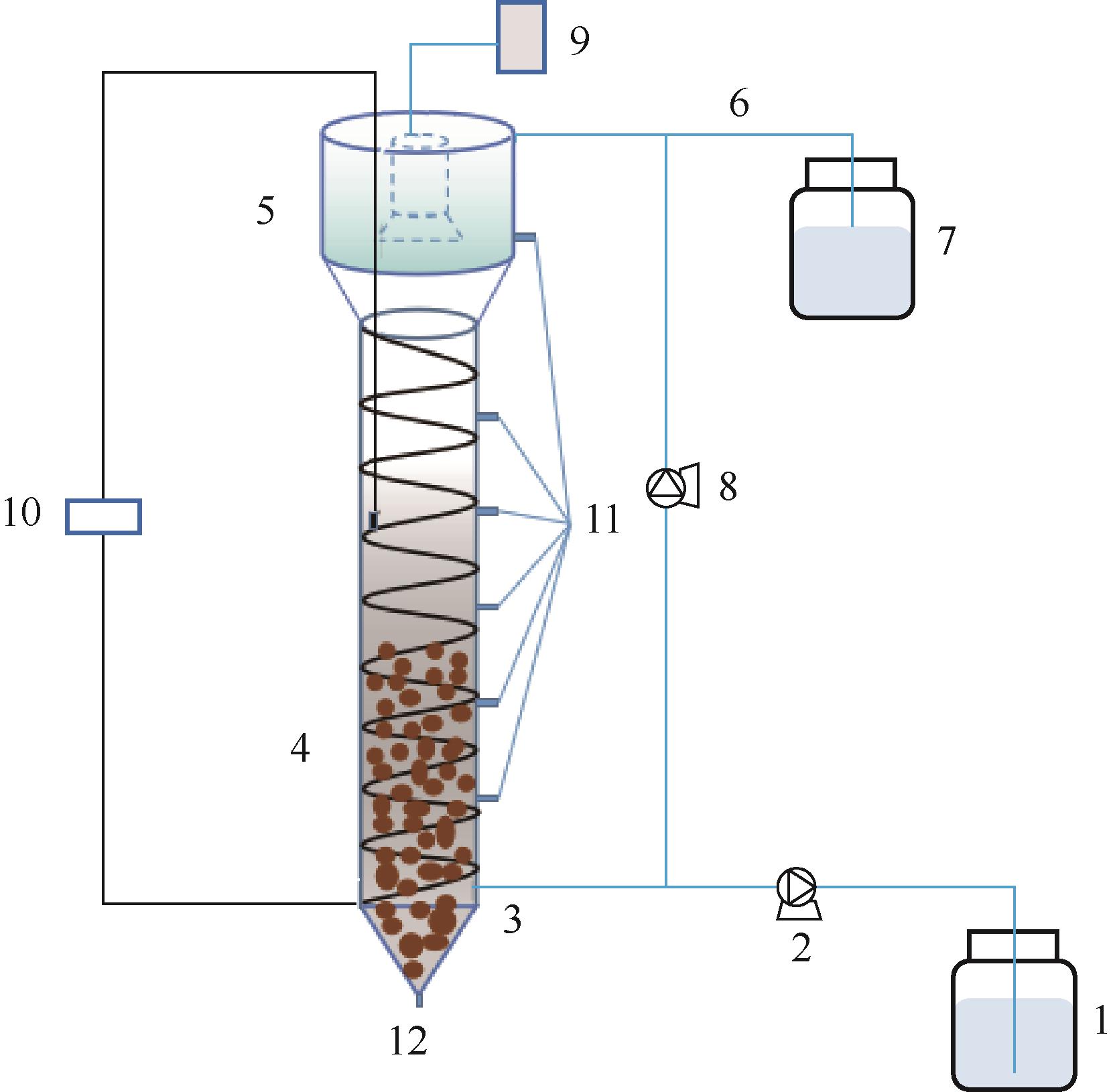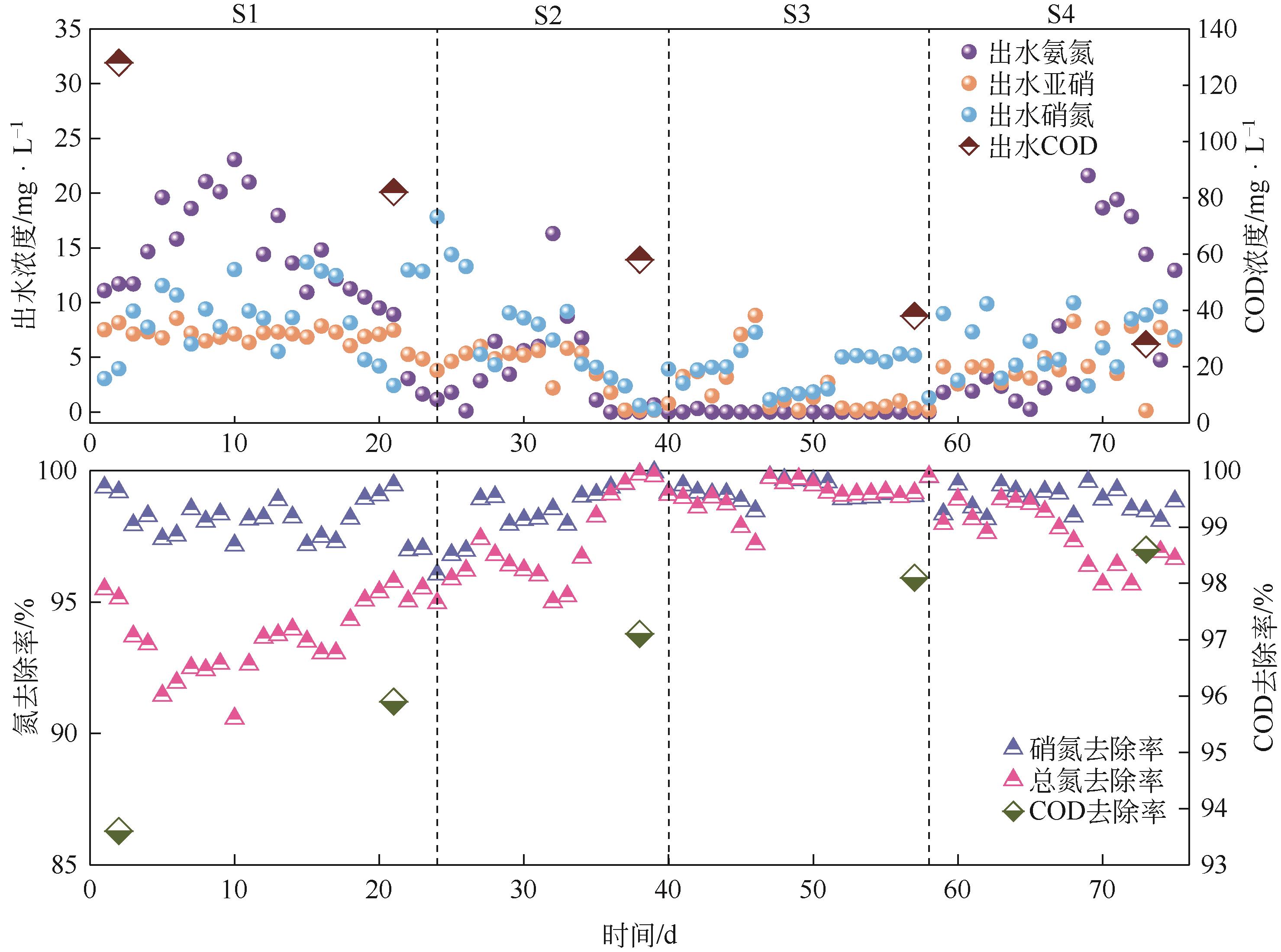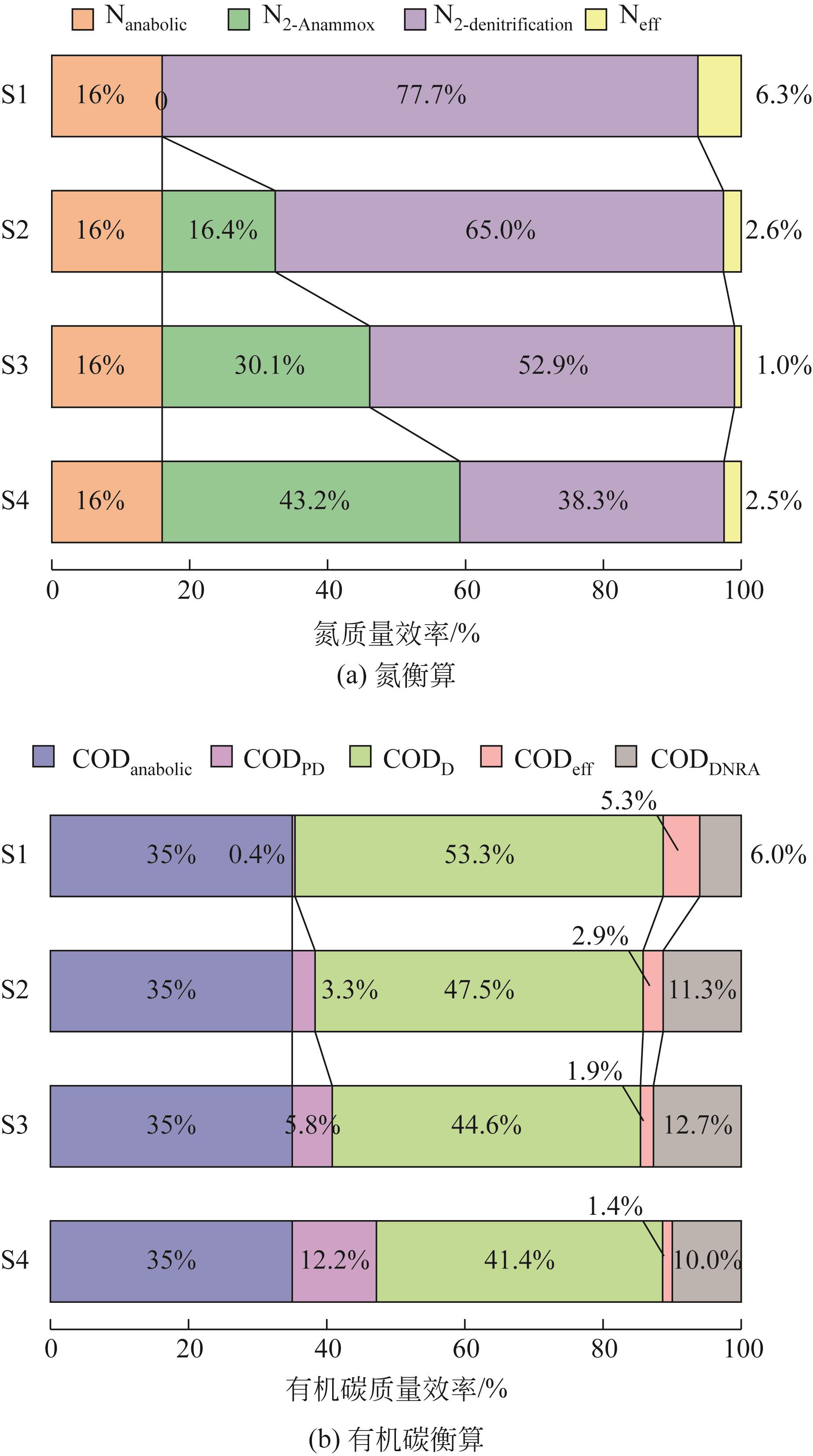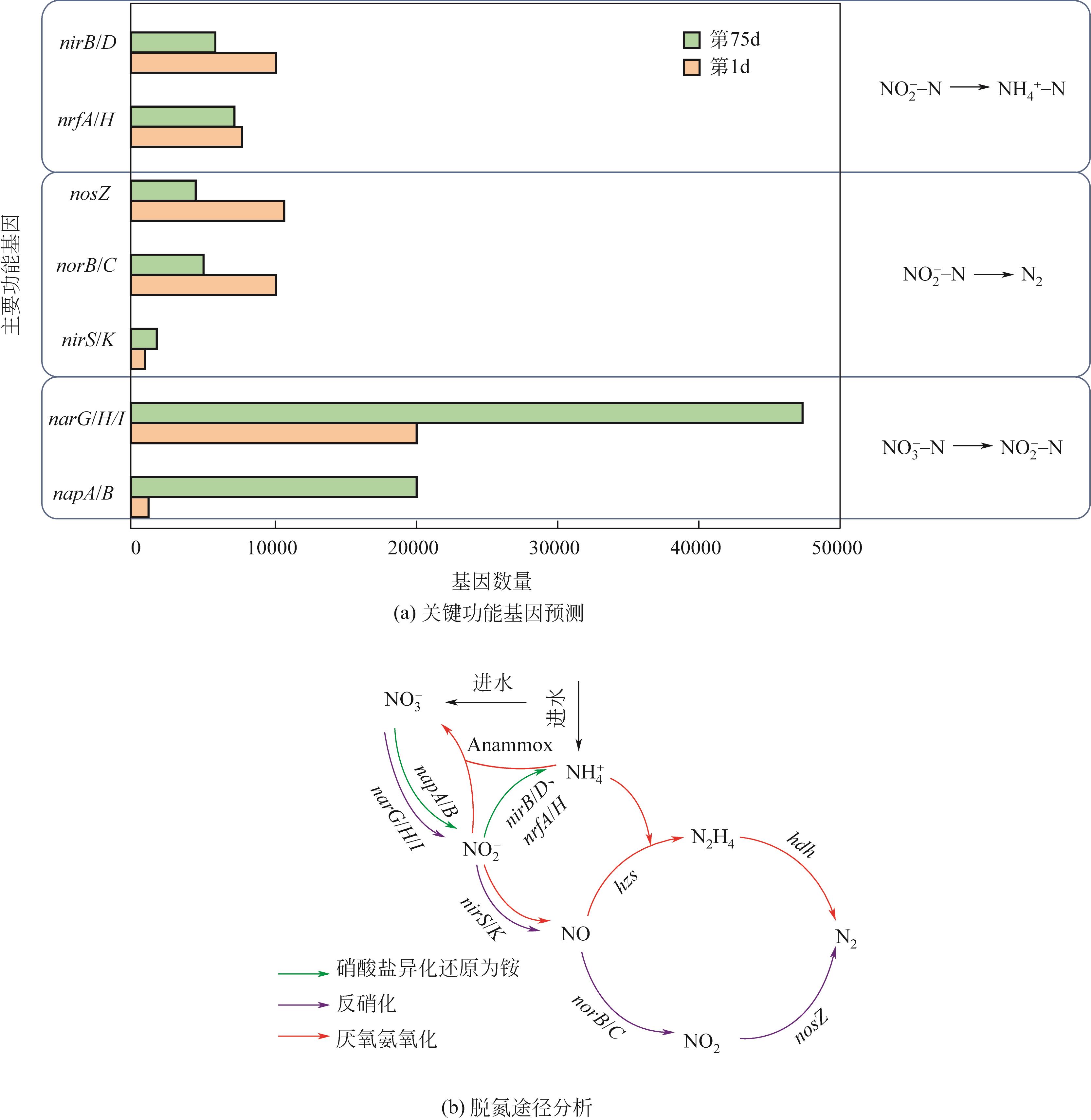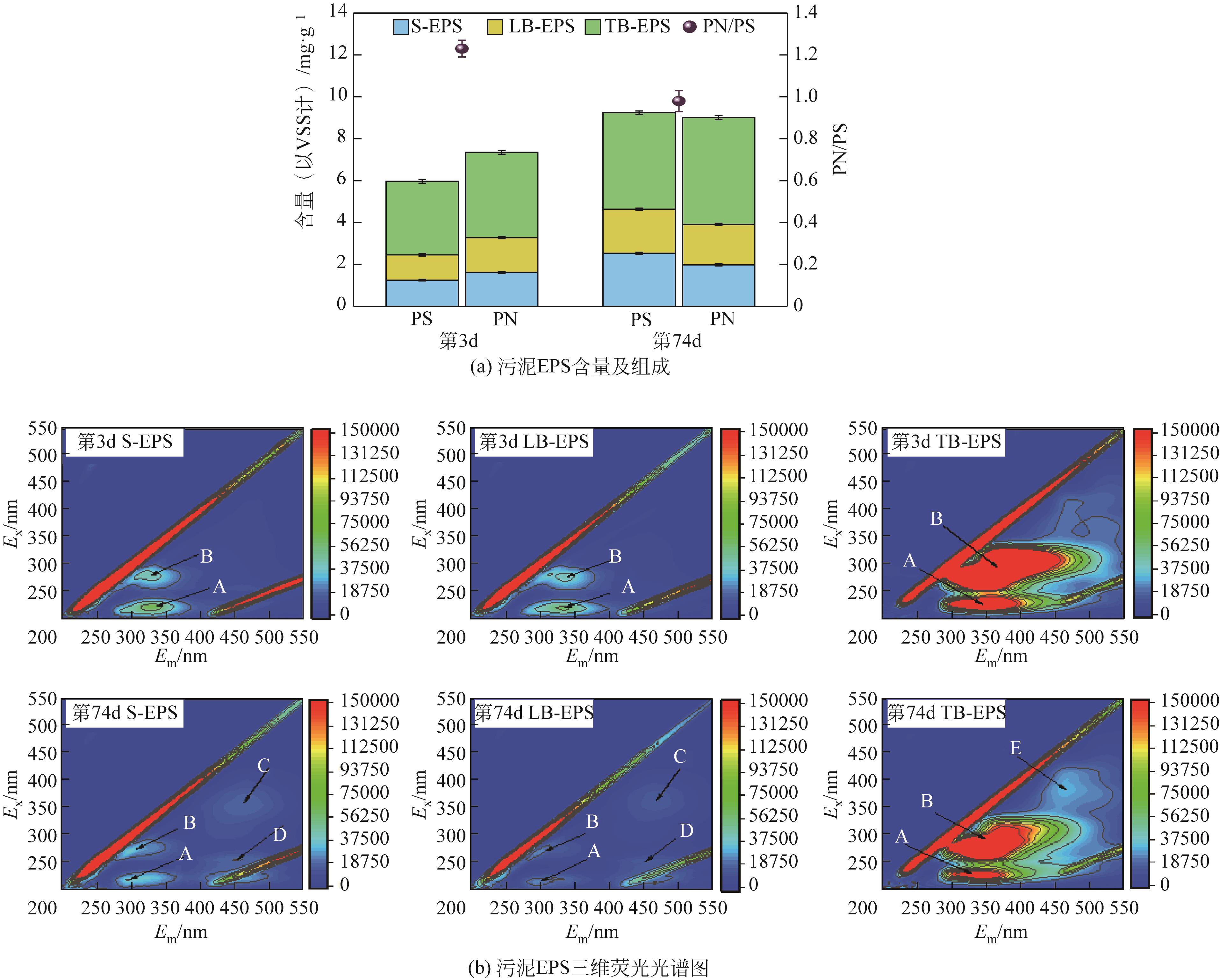Chemical Industry and Engineering Progress ›› 2024, Vol. 43 ›› Issue (3): 1593-1605.DOI: 10.16085/j.issn.1000-6613.2023-0449
• Resources and environmental engineering • Previous Articles
Construction of a coupled process integrating dissimilatory nitrate reduction and anaerobic ammonia oxidation/denitrification for wastewater treatment
ZHAO Ruiqiang1,2( ), ZHOU Xin1,2(
), ZHOU Xin1,2( ), NIU Bingxin1,2
), NIU Bingxin1,2
- 1.College of Environmental Science and Engineering, Taiyuan University of Technology, Jinzhong 030600, Shanxi, China
2.Innovation Center for Postgraduate Education in Municipal Engineering of Shanxi, Jinzhong 030600, Shanxi, China
-
Received:2023-03-23Revised:2023-05-12Online:2024-04-11Published:2024-03-10 -
Contact:ZHOU Xin
废水处理硝酸盐异化还原与厌氧氨氧化/反硝化耦合工艺构建
- 1.太原理工大学环境科学与工程学院,山西 晋中 030600
2.山西省市政工程研究生教育创新中心,山西 晋中 030600
-
通讯作者:周鑫 -
作者简介:赵瑞强(1997—),男,硕士研究生,研究方向为厌氧氨氧化技术。E-mail:1149366753@qq.com。 -
基金资助:国家自然科学基金(21607111);山西省基础研究计划(20210302123198)
CLC Number:
Cite this article
ZHAO Ruiqiang, ZHOU Xin, NIU Bingxin. Construction of a coupled process integrating dissimilatory nitrate reduction and anaerobic ammonia oxidation/denitrification for wastewater treatment[J]. Chemical Industry and Engineering Progress, 2024, 43(3): 1593-1605.
赵瑞强, 周鑫, 牛冰心. 废水处理硝酸盐异化还原与厌氧氨氧化/反硝化耦合工艺构建[J]. 化工进展, 2024, 43(3): 1593-1605.
share this article
Add to citation manager EndNote|Ris|BibTeX
URL: https://hgjz.cip.com.cn/EN/10.16085/j.issn.1000-6613.2023-0449
| 阶段 | 时间/d | COD/mg·L-1 | NO | NH | 总氮进水负荷/kg N·m-3·d-1 | COD进水负荷/kg COD·m-3·d-1 | HRT/d | C/N |
|---|---|---|---|---|---|---|---|---|
| S1 | 1~24 | 2000 | 500 | 0 | 0.25 | 1.0 | 2 | 4.0 |
| S2 | 25~40 | 2000 | 500 | 50 | 0.27 | 1.0 | 2 | 3.6 |
| S3 | 41~58 | 2000 | 500 | 100 | 0.30 | 1.0 | 2 | 3.3 |
| S4 | 59~75 | 2000 | 500 | 200 | 0.35 | 1.0 | 2 | 2.8 |
| 阶段 | 时间/d | COD/mg·L-1 | NO | NH | 总氮进水负荷/kg N·m-3·d-1 | COD进水负荷/kg COD·m-3·d-1 | HRT/d | C/N |
|---|---|---|---|---|---|---|---|---|
| S1 | 1~24 | 2000 | 500 | 0 | 0.25 | 1.0 | 2 | 4.0 |
| S2 | 25~40 | 2000 | 500 | 50 | 0.27 | 1.0 | 2 | 3.6 |
| S3 | 41~58 | 2000 | 500 | 100 | 0.30 | 1.0 | 2 | 3.3 |
| S4 | 59~75 | 2000 | 500 | 200 | 0.35 | 1.0 | 2 | 2.8 |
| 阶段 | 出水 | TN去除负荷/kg·m-3·d-1 | TN去除率/% | COD去除率/% | ||
|---|---|---|---|---|---|---|
| NH | NO | NO | ||||
| S1 | 13.3±5.8 | 6.9±1.0 | 9.0±3.8 | 0.22±0.01 | 93.7±1.4 | 94.8 |
| S2 | 3.7±4.3 | 3.6±2.2 | 6.1±4.0 | 0.25±0.01 | 97.3±1.6 | 97.1 |
| S3 | 0.0 | 2.0±2.4 | 3.7±1.8 | 0.29±0.01 | 99.0±0.6 | 98.1 |
| S4 | 8.0±7.4 | 4.6±2.2 | 6.4±2.5 | 0.34±0.01 | 97.3±1.2 | 98.6 |
| 阶段 | 出水 | TN去除负荷/kg·m-3·d-1 | TN去除率/% | COD去除率/% | ||
|---|---|---|---|---|---|---|
| NH | NO | NO | ||||
| S1 | 13.3±5.8 | 6.9±1.0 | 9.0±3.8 | 0.22±0.01 | 93.7±1.4 | 94.8 |
| S2 | 3.7±4.3 | 3.6±2.2 | 6.1±4.0 | 0.25±0.01 | 97.3±1.6 | 97.1 |
| S3 | 0.0 | 2.0±2.4 | 3.7±1.8 | 0.29±0.01 | 99.0±0.6 | 98.1 |
| S4 | 8.0±7.4 | 4.6±2.2 | 6.4±2.5 | 0.34±0.01 | 97.3±1.2 | 98.6 |
| 反应器 | 主要反应 | 进水COD浓度 /mg·L-1 | C/N | 进水氮类型 | TN进水负荷 /kg·m-3·d-1 | TN去除负荷 /kg·m-3·d-1 | TN去除率 /% | 参考 文献 |
|---|---|---|---|---|---|---|---|---|
| EGSB | DNRA、Anammox、反硝化 | 2000 | 2.8 | NH | 0.35 | 0.34 | 97.3 | 本研究 |
| UASB | PD/A | 102 | 1.7 | NH | 0.96 | 0.79 | 82.3 | [ |
| UASB | PD/A | 210 | 2 | NH | 0.50 | 0.45 | 90 | [ |
| SBR | SAD | 150 | 0.625 | NH | 0.72 | 0.65 | 86.7 | [ |
| nMBR | DNRA、Anammox、反硝化 | 850 | 10 | NO | 0.24 | 0.10 | 40 | [ |
| 反应器 | 主要反应 | 进水COD浓度 /mg·L-1 | C/N | 进水氮类型 | TN进水负荷 /kg·m-3·d-1 | TN去除负荷 /kg·m-3·d-1 | TN去除率 /% | 参考 文献 |
|---|---|---|---|---|---|---|---|---|
| EGSB | DNRA、Anammox、反硝化 | 2000 | 2.8 | NH | 0.35 | 0.34 | 97.3 | 本研究 |
| UASB | PD/A | 102 | 1.7 | NH | 0.96 | 0.79 | 82.3 | [ |
| UASB | PD/A | 210 | 2 | NH | 0.50 | 0.45 | 90 | [ |
| SBR | SAD | 150 | 0.625 | NH | 0.72 | 0.65 | 86.7 | [ |
| nMBR | DNRA、Anammox、反硝化 | 850 | 10 | NO | 0.24 | 0.10 | 40 | [ |
| 反应器 | 接种污泥 | 培养方式 | 进水氮源 | 最高总氮去除率/% | 启动时间/d | 参考文献 |
|---|---|---|---|---|---|---|
| EGSB | 厌氧颗粒污泥、5%厌氧氨氧化污泥 | 有机添加 | NH | 99.0±0.6 | 58 | 本研究 |
| UASB | 厌氧氨氧化污泥和活性污泥,体积比1∶2 | 无机添加 | NH | 87.60 | 90 | [ |
| EGSB | 厌氧颗粒污泥 | 无机添加 | NH | 83 | 93 | [ |
| 好氧活性污泥 | 无机添加 | 81 | 63 | |||
| ABBR | 好氧活性污泥 | 无机添加 | NH | >70 | 47 | [ |
| UASB | 混合活性污泥 | 无机添加 | NH | 98 | 85 | [ |
| MBR | 混合活性污泥 | 无机添加 | NH | >90 | 59 | [ |
| ASBR | 恶臭沉积物 | 无机添加 | NH | 53.7 | 60 | [ |
| 反应器 | 接种污泥 | 培养方式 | 进水氮源 | 最高总氮去除率/% | 启动时间/d | 参考文献 |
|---|---|---|---|---|---|---|
| EGSB | 厌氧颗粒污泥、5%厌氧氨氧化污泥 | 有机添加 | NH | 99.0±0.6 | 58 | 本研究 |
| UASB | 厌氧氨氧化污泥和活性污泥,体积比1∶2 | 无机添加 | NH | 87.60 | 90 | [ |
| EGSB | 厌氧颗粒污泥 | 无机添加 | NH | 83 | 93 | [ |
| 好氧活性污泥 | 无机添加 | 81 | 63 | |||
| ABBR | 好氧活性污泥 | 无机添加 | NH | >70 | 47 | [ |
| UASB | 混合活性污泥 | 无机添加 | NH | 98 | 85 | [ |
| MBR | 混合活性污泥 | 无机添加 | NH | >90 | 59 | [ |
| ASBR | 恶臭沉积物 | 无机添加 | NH | 53.7 | 60 | [ |
| EPS | 阶段 | A峰 | B峰 | C峰 | D峰 | E峰 | |||||
|---|---|---|---|---|---|---|---|---|---|---|---|
(Ex/Em) /(nm/nm) | 荧光强度 | (Ex/Em) /(nm/nm) | 荧光强度 | (Ex/Em) /(nm/nm) | 荧光强度 | (Ex/Em) /(nm/nm) | 荧光强度 | (Ex/Em) /(nm/nm) | 荧光强度 | ||
| S-EPS | S1 | 222/330 | 64983 | 282/315 | 44313 | 354/460 | 18571 | 256/460 | 19266 | ||
| S4 | 218/295 | 40230 | 270/300 | 36790 | |||||||
| LB-EPS | S1 | 220/335 | 59948 | 278/335 | 41359 | 362/460 | 14143 | 254/460 | 14757 | ||
| S4 | 216/295 | 23497 | 272/300 | 24818 | |||||||
| TB-EPS | S1 | 226/345 | 326406 | 286/350 | 750172 | 382/465 | 30047 | ||||
| S4 | 226/345 | 214944 | 284/345 | 472846 | |||||||
| EPS | 阶段 | A峰 | B峰 | C峰 | D峰 | E峰 | |||||
|---|---|---|---|---|---|---|---|---|---|---|---|
(Ex/Em) /(nm/nm) | 荧光强度 | (Ex/Em) /(nm/nm) | 荧光强度 | (Ex/Em) /(nm/nm) | 荧光强度 | (Ex/Em) /(nm/nm) | 荧光强度 | (Ex/Em) /(nm/nm) | 荧光强度 | ||
| S-EPS | S1 | 222/330 | 64983 | 282/315 | 44313 | 354/460 | 18571 | 256/460 | 19266 | ||
| S4 | 218/295 | 40230 | 270/300 | 36790 | |||||||
| LB-EPS | S1 | 220/335 | 59948 | 278/335 | 41359 | 362/460 | 14143 | 254/460 | 14757 | ||
| S4 | 216/295 | 23497 | 272/300 | 24818 | |||||||
| TB-EPS | S1 | 226/345 | 326406 | 286/350 | 750172 | 382/465 | 30047 | ||||
| S4 | 226/345 | 214944 | 284/345 | 472846 | |||||||
| 33 | LI Jia, ZHANG Liang, LIU Jie, et al. Investigation of the phenomenon and influencing factor of partial denitrification in anoxic zone of a municipal wastewater treatment plant[J]. Acta Scientiae Circumstantiae, 2021, 41(1): 109-117. |
| 34 | ZHOU Xin, ZHANG Zeqian, ZHANG Xinai, et al. A novel single-stage process integrating simultaneous COD oxidation, partial nitritation-denitritation and anammox (SCONDA) for treating ammonia-rich organic wastewater[J]. Bioresource Technology, 2018, 254: 50-55. |
| 35 | XIE Junxiang, GUO Menglei, XIE Jiawei, et al. COD inhibition alleviation and Anammox granular sludge stability improvement by biochar addition[J]. Journal of Cleaner Production, 2022, 345: 131167. |
| 36 | Hokwan HEO, KWON Miye, SONG Bongkeun, et al. Involvement of NO3 – in ecophysiological regulation of dissimilatory nitrate/nitrite reduction to ammonium (DNRA) is implied by physiological characterization of soil DNRA bacteria isolated via a colorimetric screening method[J]. Applied and Environmental Microbiology, 2020, 86(17): 01054-20. |
| 37 | MIAO Lei, ZHANG Qiong, WANG Shuying, et al. Characterization of EPS compositions and microbial community in an Anammox SBBR system treating landfill leachate[J]. Bioresource Technology, 2018, 249: 108-116. |
| 38 | LI Min, SU Junfeng, LI Yifei, et al. Suspended membrane bioreactor with extracellular polymeric substances as reserve carbon source for low carbon to nitrogen ratio wastewater: Performance and microbial community composition[J]. Korean Journal of Chemical Engineering, 2021, 38(9): 1870-1879. |
| 39 | JORAND F, BOUÉ-BIGNE F, BLOCK J C, et al. Hydrophobic/hydrophilic properties of activated sludge exopolymeric substances[J]. Water Science and Technology, 1998, 37(4/5): 307-315. |
| 40 | FRANCO A, ROCA E, LEMA J M. Granulation in high-load denitrifying upflow sludge bed (USB) pulsed reactors[J]. Water Research, 2006, 40(5): 871-880. |
| 41 | WANG Weigang, YAN Yuan, ZHAO Yuhao, et al. Characterization of stratified EPS and their role in the initial adhesion of Anammox consortia[J]. Water Research, 2020, 169: 115223. |
| 42 | WANG Zichao, GAO Mengchun, XIN Yanjun, et al. Effect of C/N ratio on extracellular polymeric substances of activated sludge from an anoxic-aerobic sequencing batch reactor treating saline wastewater[J]. Environmental Technology, 2014, 35(22): 2821-2828. |
| 43 | ZHU Liang, ZHOU Jiaheng, Meile LYU, et al. Specific component comparison of extracellular polymeric substances (EPS) in flocs and granular sludge using EEM and SDS-PAGE[J]. Chemosphere, 2015, 121: 26-32. |
| 44 | 吕姗姗, 周鑫, 海岩, 等. 微氧同步产甲烷反硝化系统颗粒污泥形成特性[J]. 化工环保, 2023, 43(1): 42-49. |
| 1 | RÜTTING T, BOECKX P, MÜLLER C, et al. Assessment of the importance of dissimilatory nitrate reduction to ammonium for the terrestrial nitrogen cycle[J]. Biogeosciences, 2011, 8(7): 1779-1791. |
| 2 | 万雨轩, 王鑫. 废水处理中异化硝酸盐还原为铵的研究进展[J]. 土木与环境工程学报, 2021, 43(6): 134-144. |
| WAN Yuxuan, WANG Xin. Research progress of dissimilatory nitrate reduction to ammonium in wastewater treatment[J]. Journal of Civil and Environmental Engineering, 2021, 43(6): 134-144. | |
| 3 | WANG Shanyun, LIU Chunlei, WANG Xiaoxia, et al. Dissimilatory nitrate reduction to ammonium (DNRA) in traditional municipal wastewater treatment plants in China: Widespread but low contribution[J]. Water Research, 2020, 179: 115877. |
| 4 | WANG Qiaojuan, LIANG Jinsong, ZHAO Chen, et al. Wastewater treatment plant upgrade induces the receiving river retaining bioavailable nitrogen sources[J]. Environmental Pollution, 2020, 263: 114478. |
| 5 | PEDRO Soares-Castro, YADAV Trilok C, Viggor Signe, et al. Seasonal bacterial community dynamics in a crude oil refinery wastewater treatment plant[J]. Applied Microbiology and Biotechnology, 2019, 103(21): 9131-9141. |
| 6 | ZHOU Lijie, ZHAO Bikai, Pingxiang OU, et al. Core nitrogen cycle of biofoulant in full-scale anoxic & oxic biofilm-membrane bioreactors treating textile wastewater[J]. Bioresource Technology, 2021, 325: 124667. |
| 7 | WANG Weigang, WANG Tong, LIU Qinghua, et al. Biochar-mediated DNRA pathway of Anammox bacteria under varying COD/N ratios[J]. Water Research, 2022, 212: 118100. |
| 8 | HARDISON Amber K, ALGAR Christopher K, GIBLIN Anne E, et al. Influence of organic carbon and nitrate loading on partitioning between dissimilatory nitrate reduction to ammonium (DNRA) and N2 production[J]. Geochimica et Cosmochimica Acta, 2015, 164: 146-160. |
| 9 | AKUNNA J C, BIZEAU C, MOLETTA R. Nitrate and nitrite reductions with anaerobic sludge using various carbon sources: Glucose, glycerol, acetic acid, lactic acid and methanol[J]. Water Research, 1993, 27(8): 1303-1312. |
| 10 | DONG Liang F, SOBEY Milika Naqasima, SMITH Cindy J, et al. Dissimilatory reduction of nitrate to ammonium, not denitrification or Anammox, dominates benthic nitrate reduction in tropical estuaries[J]. Limnology and Oceanography, 2011, 56(1): 279-291. |
| 11 | LAI Thang V, RYDER Maarten H, RATHJEN Judith R, et al. Dissimilatory nitrate reduction to ammonium increased with rising temperature[J]. Biology and Fertility of Soils, 2021, 57(3): 363-372. |
| 44 | Shanshan LYU, ZHOU Xin, Yan HAI, et al. Formation characterization of granular sludge in a micro-oxygen system for simultaneous methanogenesis and denitrification[J]. Environmental Protection of Chemical Industry, 2023, 43(1): 42-49. |
| 45 | WANG Zhiwei, WU Zhichao, TANG Shujuan. Characterization of dissolved organic matter in a submerged membrane bioreactor by using three-dimensional excitation and emission matrix fluorescence spectroscopy[J]. Water Research, 2009, 43(6): 1533-1540. |
| 46 | GEYIK Ayşe Gül, Ferhan ÇEÇEN. Production of protein- and carbohydrate-EPS in activated sludge reactors operated at different carbon to nitrogen ratios[J]. Journal of Chemical Technology & Biotechnology, 2016, 91(2): 522-531. |
| 12 | KARTAL B, KUENEN J G, VAN LOOSDRECHT M C M. Sewage treatment with Anammox[J]. Science, 2010, 328(5979): 702-703. |
| 13 | 张星星, 张钰, 王超超, 等. 短程反硝化耦合厌氧氨氧化工艺及其应用前景研究进展[J]. 化工进展, 2020, 39(5): 1981-1991. |
| ZHANG Xingxing, ZHANG Yu, WANG Chaochao, et al. Research advances in application prospect of partial denitrification coupled with Anammox: A review[J]. Chemical Industry and Engineering Progress, 2020, 39(5): 1981-1991. | |
| 14 | CASTRO-BARROS Celia M, JIA Mingsheng, VAN LOOSDRECHT Mark C M, et al. Evaluating the potential for dissimilatory nitrate reduction by Anammox bacteria for municipal wastewater treatment[J]. Bioresource Technology, 2017, 233: 363-372. |
| 15 | AHMAD Hafiz Adeel, GUO Beibei, ZHUANG Xuming, et al. A twilight for the complete nitrogen removal via synergistic partial-denitrification, Anammox, and DNRA process[J]. NPJ Clean Water, 2021, 4: 31. |
| 16 | SHENG Hao, WENG Rui, HE Yan, et al. The coupling of mixotrophic denitrification, dissimilatory nitrate reduction to ammonium (DNRA) and anaerobic ammonium oxidation (Anammox) promoting the start-up of anammox by addition of calcium nitrate[J]. Bioresource Technology, 2021, 341: 125822. |
| 17 | ZHOU Xin, WANG Gonglei, GE Daling, et al. Development of aerobic methane oxidation, denitrification coupled to methanogenesis (AMODM) in a microaerophilic expanded granular sludge blanket biofilm reactor[J]. Journal of Environmental Management, 2020, 275: 111280. |
| 18 | ZHANG Peng, FANG Fang, CHEN Youpeng, et al. Composition of EPS fractions from suspended sludge and biofilm and their roles in microbial cell aggregation[J]. Chemosphere, 2014, 117: 59-65. |
| 19 | DU Rui, CAO Shenbin, LI Xiangchen, et al. Efficient partial-denitrification/Anammox (PD/A) process through gas-mixing strategy: System evaluation and microbial analysis[J]. Bioresource Technology, 2020, 300: 122675. |
| 20 | HAN Hao, LI Jun, ZHANG Jing, et al. Enhancing the treatment performance of partial denitrification/Anammox process at high nitrogen load: Effects of immobilized strain HFQ8C/N on the sludge characteristics[J]. Bioresource Technology, 2021, 341: 125870. |
| 21 | LI Jin, QIANG Zhimin, YU Deshuang, et al. Performance and microbial community of simultaneous Anammox and denitrification (SAD) process in a sequencing batch reactor[J]. Bioresource Technology, 2016, 218: 1064-1072. |
| 22 | WANG Zhibin, BU Cuina, DOU Jianghai, et al. Enrichment of DNRA bacteria: Shift of microbial community and its combination with Anammox to promote TN removal[J]. Journal of Environmental Chemical Engineering, 2022, 10(6): 108867. |
| 23 | 廉静, 赵大密, 王振毅, 等. 厌氧氨氧化反应器启动特性及基质比优化调控[J]. 安全与环境学报, 2024, 24(2): 722-731. |
| LIAN Jing, ZHAO Dami, WANG Zhenyi, et al. Characteristics of Anammox reactor and optimal regulation of substrate ratio during start-up process[J]. Journal of Safety and Environment, 2024, 24(2): 722-731. | |
| 24 | 夏兴良, 梁志超, 苏柳, 等. 基于EGSB反应器的不同接种污泥启动厌氧氨氧化特性研究[J]. 水处理技术, 2023, 49(4): 128-133. |
| XIA Xingliang, LIANG Zhichao, SU Liu, et al. The characteristics of different inoculated sludge starting anaerobic ammonia oxidation based on the EGSB reactor[J]. Technology of Water Treatment, 2023, 49(4): 128-133. | |
| 25 | WANG Tao, WANG Xian, YUAN Luzi, et al. Start-up and operational performance of Anammox process in an anaerobic baffled biofilm reactor (ABBR) at a moderate temperature[J]. Bioresource Technology, 2019, 279: 1-9. |
| 26 | CHEN Chongjun, HUANG Xiaoxiao, LEI Chenxiao, et al. Improving Anammox start-up with bamboo charcoal[J]. Chemosphere, 2012, 89(10): 1224-1229. |
| 27 | WANG Tao, ZHANG Hanmin, GAO Dawen, et al. Comparison between MBR and SBR on Anammox start-up process from the conventional activated sludge[J]. Bioresource Technology, 2012, 122: 78-82. |
| 28 | LEE Jae-Kune, CHOI Chang-Kyoo, LEE Kwang-Ho, et al. Mass balance of nitrogen, and estimates of COD, nitrogen and phosphorus used in microbial synthesis as a function of sludge retention time in a sequencing batch reactor system[J]. Bioresource Technology, 2008, 99(16): 7788-7796. |
| 29 | 陈重军, 张海芹, 汪瑶琪, 等. 基于高通量测序的ABR厌氧氨氧化反应器各隔室细菌群落特征分析[J]. 环境科学, 2016, 37(7): 2652-2658. |
| CHEN Chongjun, ZHANG Haiqin, WANG Yaoqi, et al. Characteristics of microbial community in each compartment of ABR Anammox reactor based on high-throughput sequencing[J]. Environmental Science, 2016, 37(7): 2652-2658. | |
| 30 | ZHAO Yunpeng, LIU Shufeng, JIANG Bo, et al. Genome-centered metagenomics analysis reveals the symbiotic organisms possessing ability to cross-feed with anammox bacteria in anammox consortia[J]. Environmental Science & Technology, 2018, 52(19): 11285-11296. |
| 31 | SPETH Daan R, IN’T ZANDT Michiel H, Simon GUERRERO-CRUZ, et al. Genome-based microbial ecology of Anammox granules in a full-scale wastewater treatment system[J]. Nature Communications, 2016, 7: 11172. |
| 32 | SLOBODKINA Galina B, KOVALEVA Olga L, MIROSHNICHENKO Margarita L, et al. Thermogutta terrifontis gen. nov., sp. nov. and Thermogutta hypogea sp. nov., thermophilic anaerobic representatives of the Phylum planctomycetes[J]. International Journal of Systematic and Evolutionary Microbiology, 2015, 65(3): 760-765. |
| 33 | 李佳, 张亮, 刘杰, 等. 城市污水处理厂缺氧池短程反硝化现象及影响因素研究[J]. 环境科学学报, 2021, 41(1): 109-117. |
| [1] | WANG Lele, YANG Wanrong, YAO Yan, LIU Tao, HE Chuan, LIU Xiao, SU Sheng, KONG Fanhai, ZHU Canghai, XIANG Jun. Influence of spent SCR catalyst blending on the characteristics and deNO x performance for new SCR catalyst [J]. Chemical Industry and Engineering Progress, 2023, 42(S1): 489-497. |
| [2] | XU Zhongshuo, ZHOU Panpan, WANG Yuhui, HUANG Wei, SONG Xinshan. Advances in sulfur iron ore mediated autotrophic denitrification [J]. Chemical Industry and Engineering Progress, 2023, 42(9): 4863-4871. |
| [3] | LI Baixue, XIN Xin, ZHU Yumeng, LIU Qin, LIU Xin. Construction of sulfur autotrophic short-cut denitrification and anaerobic ammonium oxidation (SASD-A) coupling system and effect mechanisms of influent S/N ratio on denitrification process [J]. Chemical Industry and Engineering Progress, 2023, 42(6): 3261-3271. |
| [4] | ZHANG Wei, QIN Chuan, XIE Kang, ZHOU Yunhe, DONG Mengyao, LI Jie, TANG Yunhao, MA Ying, SONG Jian. Application and performance enhancement challenges of H2-SCR modified platinum-based catalysts for low-temperature denitrification [J]. Chemical Industry and Engineering Progress, 2023, 42(6): 2954-2962. |
| [5] | WU Xinbo, DANG Hongzhong, MA Jiao, YAN Yuan, ZENG Tianxu, LI Weiwei, ZHANG Guozhen, CHEN Yongzhi. Effect of denitrifying phosphorus removal under short-cut nitrification mode with A2/O-BAF process [J]. Chemical Industry and Engineering Progress, 2023, 42(2): 1089-1097. |
| [6] | SONG Yukun, WANG Guogang, ZHANG Xingong, LIU Dakuo, ZHANG Jinqing, LIN Han. SNAR: a new non-amino reduction technology for acid and denitration [J]. Chemical Industry and Engineering Progress, 2022, 41(S1): 606-612. |
| [7] | YANG Xigang, CHEN Guoqing, HUANG Linbin, GU Shijun, LI Changsong, ZHANG Yong, JIN Baosheng. Industrial experiment on the effect of SNCR using urea as the reducing agent on the operation of large capacity power station pulverized coal boiler [J]. Chemical Industry and Engineering Progress, 2022, 41(7): 3573-3581. |
| [8] | WANG Chaochao, WU Yiling, CHEN Jiaqiao, CAI Tianning, LIU Wenru, LI Xiang, WU Peng. A novel anaerobic hydrolysis acidification-partial denitrification anaerobic ammonia oxidation process for advanced nitrogen removal from simulated domestic and nitrate-containing wastewater [J]. Chemical Industry and Engineering Progress, 2022, 41(7): 3890-3899. |
| [9] | WANG Yuguang, ZHANG Xingxing, WANG Chaochao, XIA Yunkang, WANG Yao, ZHOU Cheng, WU Yiling, WU Peng, XU Lezhong. Achieving advanced nitrogen and phosphorus removal based on denitrifying phosphorus removal and partial denitrification Anammox process [J]. Chemical Industry and Engineering Progress, 2022, 41(4): 2191-2201. |
| [10] | LIU Feng, ZHANG Xuezhi, WANG Suqin, FENG Zhen, GE Dandan, YANG Yang. Thiosulfate-driven denitrification coupled with ANAMMOX to enhance total nitrogen removal [J]. Chemical Industry and Engineering Progress, 2022, 41(2): 990-997. |
| [11] | NI Qing, LAI Jinbo, PENG Dongyue, GUAN Cuishi, LONG Jun. Progress in extraction separation of hydrocarbons by ionic liquids [J]. Chemical Industry and Engineering Progress, 2022, 41(2): 619-627. |
| [12] | CHEN Zhihua, ZHOU Jian, WANG Sanfan. Summary of solid phase denitrification in water pollution control [J]. Chemical Industry and Engineering Progress, 2021, 40(S1): 366-374. |
| [13] | YAN Wenjie, XIONG Yuanquan, YANG Siyuan, HE Shanshan. NO preoxidation by gas phase Fenton reaction with Fe2O3 over rice husk-based silica carrier [J]. Chemical Industry and Engineering Progress, 2021, 40(7): 4027-4035. |
| [14] | HAO Runlong, QIAN Zhen, FU Le, YUAN Bo. Research progress of microwave-induced catalytic denitrification [J]. Chemical Industry and Engineering Progress, 2021, 40(5): 2747-2752. |
| [15] | LEI Xin, YAN Rong, MU Yujie, ZHANG Yuancan, FU Zhimin. Effect of iron on nitrogen removal efficiency of anaerobic ammonium oxidation bacteria [J]. Chemical Industry and Engineering Progress, 2021, 40(5): 2730-2738. |
| Viewed | ||||||
|
Full text |
|
|||||
|
Abstract |
|
|||||
